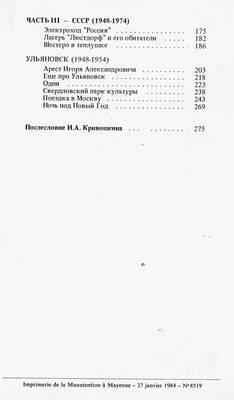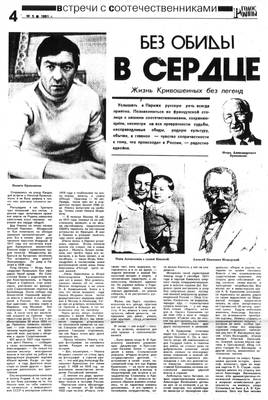Krivoshein Igor Alexandrovich
Engineer, participant in the Resistance movement in France during World War II
Genus. in 1899 in St. Petersburg. After completing the accelerated course of the Corps of Pages, he served in the reserve battery of Pavlovsk. Participant of the 1st World and Civil Wars. In 1920, together with his father, he was evacuated from Crimea to Constantinople, and in the same year he moved to Paris. Graduated from the Faculty of Physics and Mathematics of the Sorbonne and the Higher Electrical Engineering School. He worked in the telephone company, in the testing laboratory of the Apel society, and from 1928 - chief engineer at the Lemercier Frères plant in Clichy. He was a member of the council of the Russian Trade, Industrial and Financial Union. With the outbreak of World War 2 he joined the Resistance. 06/22/1941, together with other Russian emigrants, he was arrested and placed in the Compiegne camp, where he stayed for several weeks. In June 1944 he was arrested again and sentenced to life imprisonment. He was held in the Frans prison in Paris, from there he was sent to Buchenwald, and subsequently transferred to the Dachau concentration camp, from where he was released by American troops in May 1945. Awarded the Resistance Medal.
Member of the organizing committee “Russian Help” and the Union of Soviet Patriots. In 1946, he applied to the Soviet consulate to restore USSR citizenship. A year later, by order of the French Minister of Internal Affairs, he was arrested among 24 “new Soviet citizens”, and in November 1947 he was expelled from France to the USSR. From February 1948 he lived in Ulyanovsk, worked as an engineer at the “literary” plant No. 650. And he was arrested on September 20, 1949 “for collaboration with the international bourgeoisie”, sentenced to 10 years in the camps. From 1950 to 1953 he was kept near Moscow at “special facility 18” (Marfinsky “sharashka”) together with A. Solzhenitsyn and L. Kopelev; subsequently transferred to Taishet. In 1954 he was released and settled in Moscow, where he was engaged in technical translation. In 1974 he returned to Paris. He died in Paris on August 7, 1987, and was buried in the Sainte-Geneviève-des-Bois cemetery.
Доп. инф. Доп. инф.: Дом русского зарубежья им. А.И. Солженицына [Электрон. ресурс]. URL: https://www.domrz.ru/ (дата обращения: 2023 г.).
Documents (6)
Fund 03 (Б-2) / Inventory 1 / Case Кривошеин Никита Игоревич
1. Afterword by I.A. Krivoshein to the book by N.A. Krivosheina “Four Thirds of Our Life” (Paris, 1984, series “All-Russian Memoir Library”), pp. 275-282.






Fund 03 (Б-2) / Inventory 1 / Case Кривошеин Никита Игоревич
2. Review by Garder M.V. based on the book by Krivosheina N.A. “Four Thirds of Our Lives” in The New Review, New York, Vol. 156 for 1984, pp. 292-297.




Fund 03 (Б-2) / Inventory 1 / Case Кривошеин Никита Игоревич
3. A note from V. Bogusluvsky about the publication of N.A. Krivosheina’s book. “Four thirds of our life” in the magazine “Twenty Two”, No. 45 for 1985; 2B-29.

Fund 03 (Б-2) / Inventory 1 / Case Кривошеин Никита Игоревич
4. Article by Shcheglova N. “Without resentment in the heart. The life of the Krivosheins without legends” in the newspaper “Voice of the Motherland” No. 5, 1991, pp. 4-5.


Fund 03 (Б-2) / Inventory 1 / Case Кривошеин Никита Игоревич
5. Article by V. Kichin “The end of the “beautiful era”” in the newspaper “Izvestia” dated November 6, 1997. about Russian emigrants of the first wave in Paris. (1 sheet, newspaper clipping)
